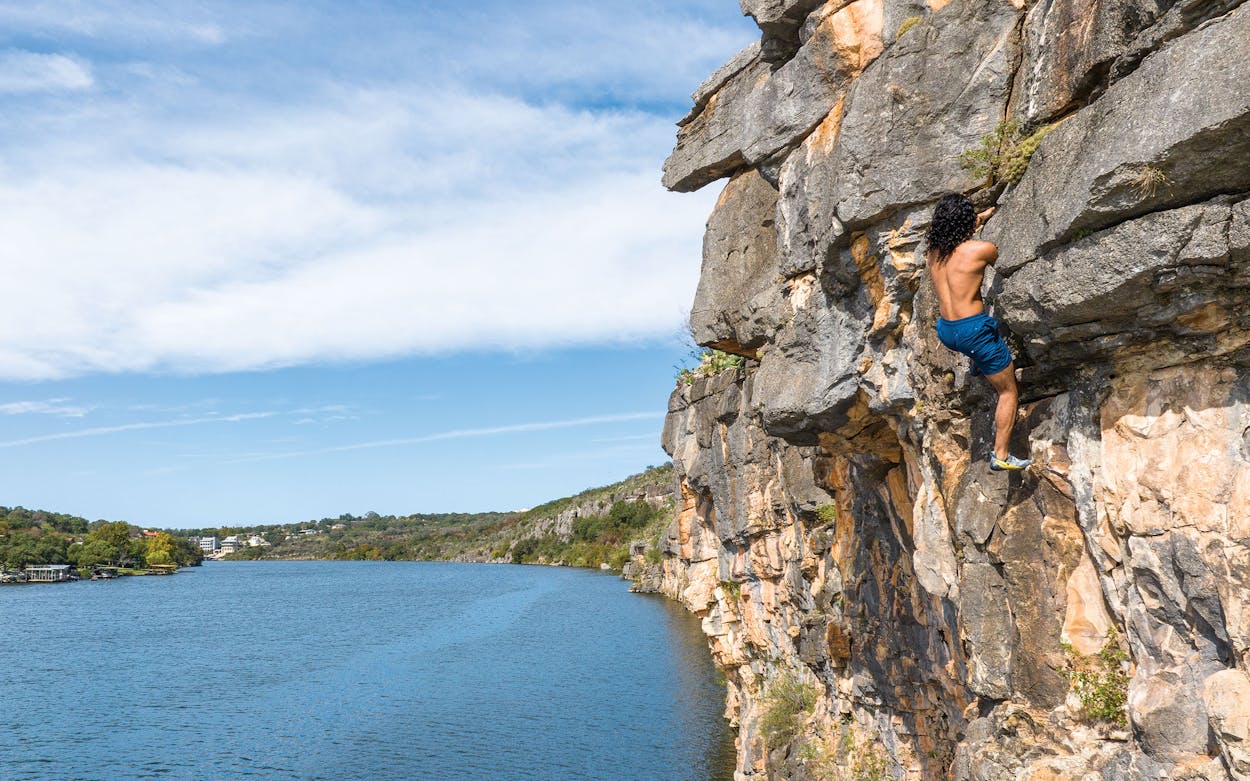The November day had dawned chilly and damp, the sun bundled in gray cloud banks. Now, in the early afternoon, the air has warmed only a few degrees, and a persistent mist slicks the limestone—horrid conditions for rock climbing. But I must try. I’ve spent three months training hard in the gym, torturing myself on a finger-strengthening device called a hangboard and doing weighted pull-ups like a maniac. I’ve gathered two friends to assist, and a drone will soon be sent aloft to capture what I have imagined, in my daydreams, as a triumphant romp to the top after nearly four years of trying to conquer this route and falling, falling, falling.
The goal seems straightforward: I must scale a vertical rock face for about seventy feet, using only my hands and feet to ascend—a practice called free-climbing. A rope is there only to catch me if I fall. As I go up, I clip it into carabiners attached to bolts sunk in the rock. If I reach the anchor, a set of bolts with chains at the top of the cliff, without falling or giving up, I will be the first to do so successfully. In the climbing world, this means that not only can I claim the “first ascent” of the route but I also get to name it, a responsibility that I, as a professional writer, take very seriously. I have thought long and hard about what this climb, with its distinct arête (a protruding edge), should be called, and I’ve come up with “Offisher, Arête This Man!”—best said in a drunken slur. Like I said, serious business. Until then, it’s just “the Project.”
I first laid eyes on the Project in 2018. My partner and I, along with six friends, had purchased some land on the Pecos River, near Langtry, in the scrubby desert lands of southwest Texas. Until we closed on the 93-acre ranchito, none of us had seen the walls of the river canyon. On our first visit after closing on the sale, we excitedly rappelled down into the 150-foot river gorge, eventually reaching a giant ledge perched above a swift chute of the churning Pecos. Above this ledge, the headwall. We craned our necks to take in the steep face of bullet-hard limestone frosted here and there with white, yellow, and orange lichen: a desert Jackson Pollock. The rock deities had smiled upon this place—and us. The climbable portions of the walls, tall by Texas standards, reach more than a hundred feet in places and boast many features: dimples, divots, pockets, and arêtes, as well as two enormous, man-eating cracks and a tongue of thin, brightly colored rock the size of a surfboard improbably wedged in a fissure. The tongue looms over the crag like a Cretaceous guillotine.
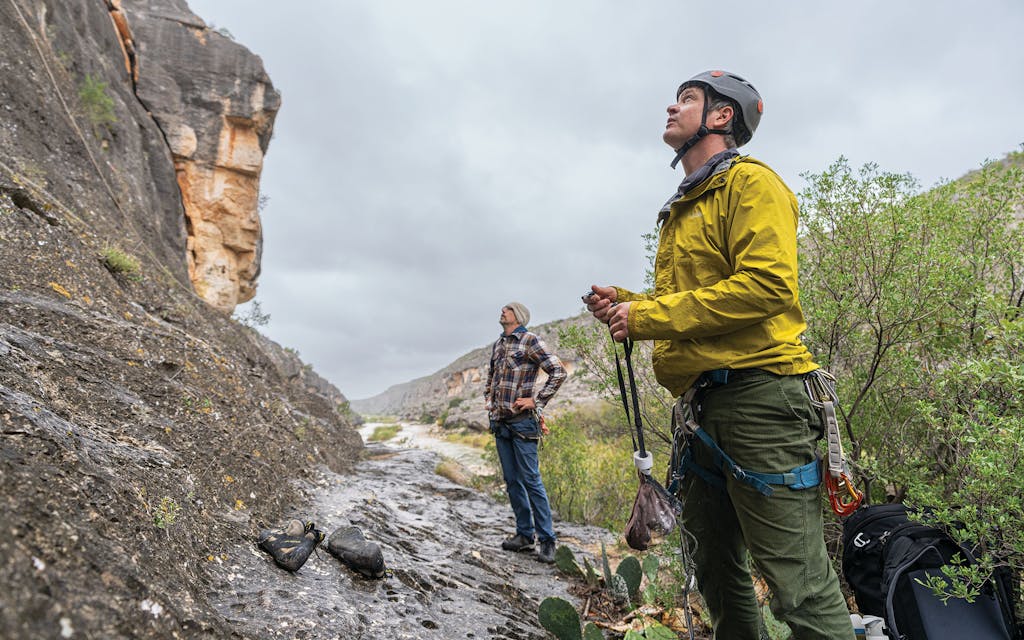
Since buying the property, my friends and I have developed a dozen or so routes, some easy, some hard. Some took months of intermittent effort to establish, from sussing out the lines to installing bolts in the rock. The harder ones required many tries before I successfully free-climbed them. But none has gripped me like the Project. I started working on it during the pandemic, frequently making the five-hour drive west from my home in Austin to do battle. Some of my stronger pals could probably ascend it in house slippers. But for me—a fortysomething with a dad bod and a mortgage, who only started climbing in earnest in his midthirties—the route felt impossible at first. It involves 25 to 30 taxing, technically difficult moves up the wall without a meaningful rest.
The hardest move, the place where I have failed dozens of times, requires standing with the right foot on a nubbin the size of a pencil eraser while the left heel clings desperately to an edge around the arête. Then the right hand shoots out to grab a semidetached sharp flake that’s almost out of reach. When—if—I stick that move, I find myself in a preposterous yogalike stance, looking at a fifteen-to-twenty-foot fall, a scary proposition even though I’d probably be fine. It took me many, many hours to figure out this delicate dance. Sometimes I can’t remember which drawer in my kitchen holds the silverware, but I know every move on the Project by heart. It may be only an obscure cliff in a forgotten corner of Texas, but it’s my Mount Everest. My white whale.
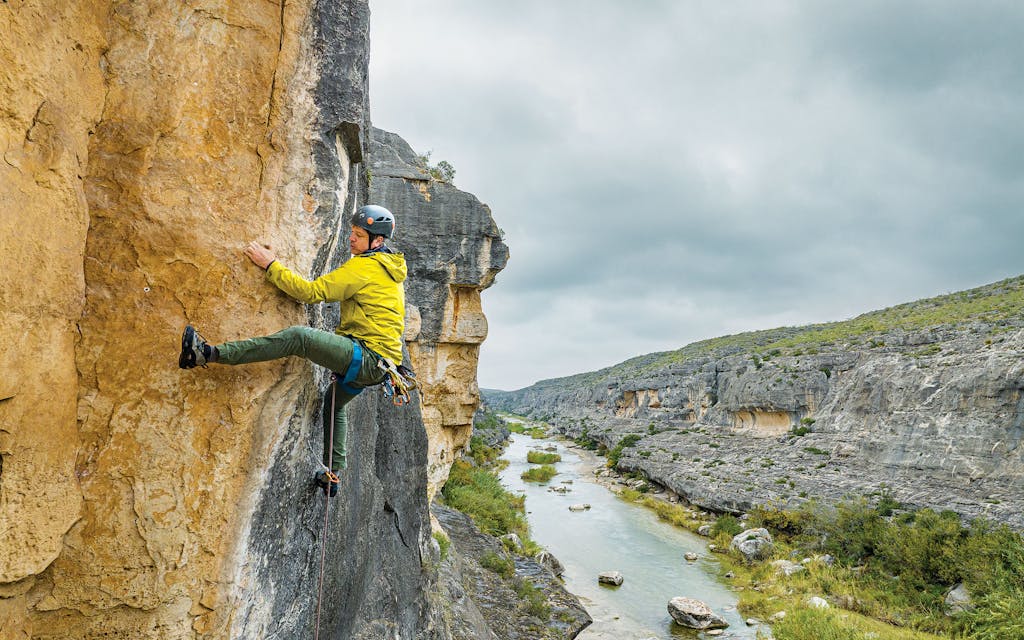
At the base of the Project, I tie into the rope, put on my rubbery climbing shoes, chalk my hands, and begin to rehearse the beta—climberspeak for the information needed to complete the route. “Once more unto the breach,” I think to myself. Shakespeare’s King Henry said it with bravado; I do so with self-mockery. I warn my friend Austin Bolen, who as my belayer is responsible for counterbalancing my weight at the other end of the rope, to get ready for a big fall.
My first surprise: despite the mist, the rock is dry. I’m almost disappointed because now I don’t have an excuse for failure. The bigger surprise: as soon as I start climbing, instead of being scared or anxious, my default states on this route, I feel no emotion at all. I am not thinking; I am simply doing. Usually I hear the swoosh of the river in my head, as if someone had pressed a conch to my ear. Or I carry on an internal monologue—I’m cold; I’m hot; what’s for dinner; climate change is a bummer. Now I don’t even hear the buzz of the drone overhead. I’m in one of those coveted and rare flow states. The world falls away, and I simply perform.
By the time I snag the flake, about halfway up, I’m only lightly fatigued. Then comes the last part of the crux, the hardest part of a route. It’s a tricky sequence above a roof (a horizontal overhang) that I had botched during a practice run the day before. It goes flawlessly. Soon I’m sitting on a ledge, inspecting the tongue, and catching my breath. The rest of the route is relatively easy. In moments, I should be at the top, celebrating. But while I’m up on that ledge, disaster strikes: my brain turns back on.
Yes, this is the cliffhanger in the story.
Once an isolated, outlaw subculture that occasionally attracted outside attention, rock climbing has been thoroughly mainstreamed over the past decade, thanks to popular documentaries such as Free Solo and The Dawn Wall, the sport’s debut at the 2020 Summer Olympics, and, more than anything else, the proliferation of climbing gyms. The appeal is multifaceted. Climbing is a great workout, it’s fun and social, and it rewards both mind and body. Brute strength isn’t enough to succeed in the vertical realm—you also need skills, tactics, and problem-solving abilities.
Although huge swaths of the Lone Star State are flat and featureless, things get interesting from the Balcones Escarpment westward into the Trans-Pecos region. Over millennia, streams have cut deep gorges into the ancient limestone seabeds of the Edwards Plateau, leaving behind steep cliffs in river valleys. Water has worked its magic at a smaller scale, forming toothy pockets, handlebars, and tubular ribs of rock known as tufas. Texas doesn’t have the attractions of mountain states such as California, Colorado, or West Virginia—our cliffs tend to be short, and a lot of the best rock sits on private property—but we still have a lot of great easy-to-access crags. From the granite cracks of Enchanted Rock State Natural Area to the pocketed boulders at Rogers Park on Belton Lake, ten miles west of Temple, to the numerous limestone bluffs around Austin, the state offers a lifetime of vertical exploration. It’s also home to Hueco Tanks State Park & Historic Site, outside El Paso, one of the world’s most important destinations for bouldering, a popular branch of the sport that emphasizes powerful movement on short routes.
In addition to its natural wonders, Texas boasts some of the best climbing gyms in the country. More than thirty commercial facilities are scattered across the state, from Amarillo to Houston. Most didn’t exist ten years ago, a testament to the growing popularity of the sport. The best put a great deal of emphasis on “setting”—the art of placing plastic holds to create movement patterns that can be thoughtful, flow-y, acrobatic, or just plain hard. Indoor climbing is a highly social activity, so different from the grunting solitude that marks most ordinary gyms, where everyone seems lost in their private pain caves. Climbing centers are to Gen Z and millennials what bowling alleys were to their grandparents.
The indoor movement has spawned a new generation of crushers. Access to excellent facilities and professional coaches means elite climbers can be produced anywhere. Some of these youngsters are lured by the prospect of posting badass content to Instagram and TikTok, while others find their way into competitive climbing, where participants go head to head on artificial walls against one another and the clock. Team Texas, based in mostly flat North Texas, has produced some of the best contenders in North America. Anastasia “Annie” Sanders, a sixteen-year-old who hails from Fort Worth, has won four gold medals at youth world championships. Now competing as an adult, she ranks number twelve in the world and, as the youngest member of the U.S. national team, has an outside shot at securing a spot at the Paris Olympics this summer.
I dabbled in outdoor climbing in my twenties, mostly at the Barton Creek Greenbelt, in Austin, where the limestone is notoriously polished from decades of clambering feet. But it wasn’t until an excellent bouldering gym opened a mile from my house in 2016 that I became immersed.
Bouldering is the simplest form of climbing. Because the “problems”—the apt name for the sequence of moves on a boulder—rarely go higher than ten or fifteen feet, no harness or rope is required, just a pair of specialized shoes. Indoors, you fall onto cushy foam mats; outdoors, you need spotters and “crash pads”—bulky, mattresslike cushions. Bouldering requires strength, coordination, balance, technique, and, above all, power. When I started, I lacked all of those. I don’t have an athletic background, and my build—six feet tall and nearly two hundred pounds—is not ideal for dangling from tiny edges. But over the course of seven years, I slowly progressed until I was “sending” problems—which in the head-scratching parlance of the sport means successfully completing a particular climb without falling—that had previously seemed impossible. I learned how to use just the tips of my fingers to crimp on thin holds, how to hang upside down like a bat, how to rest on a 45-degree incline by wedging my knee behind a hold. I figured out how to “read” a problem, plotting out each move before leaving the ground. Most important, I began to grasp the strange alchemy between mind and body that is required to master the sport.
The gym served as a gateway to real rock. Soon I began exploring the vertical dimension of Texas and seeing the state from new, wild angles. Rock climbing gave me a visceral way to embrace, quite literally, the natural world. At first it complemented my other outdoor hobbies, such as fishing, hiking, and kayaking, but over time it took over. The other pursuits just didn’t offer the same intoxicants: the rewarding sweat of intense exertion, the sweet tang of well-managed fear, and the pleasure of transgression (I really shouldn’t be up here). For the past five years, I’ve climbed, on average, three times a week. I never lose interest. Every route provides new technical puzzles. Every accomplishment, however modest, beckons new ones. Every summit, no matter how majestic or common, invites another.
One of my favorite places to climb is Enchanted Rock, the beloved natural area near Fredericksburg whose central feature, a pink granite batholith called the main dome, is summited by thousands of hikers every year. But there are bolder ways to get to the top. “E Rock,” as it’s affectionately known, offers adventurous climbing on tiny, sharp crystals and deep cracks. I typically access my favorite route, Cave Crack, by climbing up a short route called Jack Knife, then rappelling or scrambling down into a chasm and ducking into a small cave, the back of which is split by the namesake crack. Follow the fissure up and out of the cave for about 140 feet onto the main dome. You can then coil your rope and hike to the top. Cool!
Climbers began developing crags such as E Rock, the Greenbelt, and Reimers Ranch, about thirty miles west of Austin, in earnest in the seventies, often defying rules that barred bolting. They scoped out new lines, did the hard work of cleaning loose rock and sinking bolts, and then christened the routes with names such as Texas Crude and Fear of Flying. A crew of acid-dropping hippie types tried to outdo one another by putting up bold, death-defying routes on the Backside of E Rock’s main dome. In the style of the day, they pioneered the routes from the ground up rather than rappelling in, and they sunk bolts by hand in the hard granite if they could find a good stance. “The only time you added a bolt was where you absolutely had to have it or you were going to die,” says James Crump, who started climbing at E Rock in 1971, at age eleven.
In my seven years of climbing, I’ve been to E Rock, Reimers, and other crags countless times. But I’d yet to visit the state’s only world-renowned climbing destination, a place where many of the best boulderers in the world have gone to prove themselves. So in April of last year, months before I found myself close to conquering the Project, I flew to El Paso and drove about thirty miles northeast to Hueco Tanks State Park.
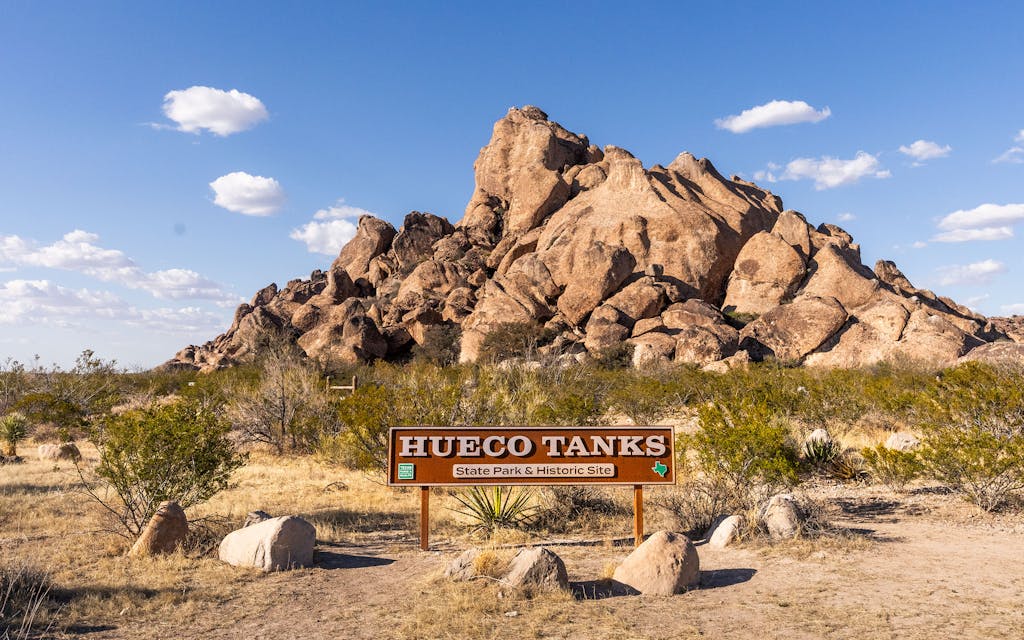
John Sherman, often simply referred to by his nickname, “Verm” (short for “Vermin”), almost didn’t believe the Texans at first. It was winter 1982, and the Californian, then 23, was playing on the otherworldly granite of Joshua Tree National Park when climbers from El Paso began bragging on their hometown crag. “At the time, it was a given in the climbing world that there was no such thing as climbing in Texas,” Sherman tells me. But based on the photos the El Pasoans shared with him, he decided to “gamble a trip” 42 years ago. “Sure enough, it was amazing,” he says. Sherman spent the next thirteen winters camping in the park or squatting in an abandoned Quonset hut with other climbers. “Back then the whole climbing world was different. It was a lot of twentysomething guys all living in the dirt—I mean, in the freaking dirt.”
Locals such as Mike Head and Bob Murray had already snagged many first ascents, classics that are still sought out today. Sherman was impressed that these Texans were climbing such difficult grades, especially so far from the limelight. But Sherman more than anyone turned Hueco into America’s bouldering mecca and changed the sport forever. Over the years, he claimed more than 3,000 first ascents (including at least 450 at Hueco), helped invent the crash pad, and came up with the V-scale, an open-ended grading system for boulders that allows the competitive minded to challenge themselves and compete against others. (The V stands for Vermin. The difficulty levels go from V0—something most beginners can handle—to V17, which only a handful of climbers have ever done.)
What makes Hueco so special is the quality of the rock along with the mind-blowing density of routes. The unusual granitelike stone rose from beneath the earth’s surface as a slug of magma 34 million years ago, settling underneath a skin of older limestone. Over time, wind and water scoured away the limestone overlay, sculpting the park’s signature huecos, or hollows. These natural water-holding dishes made the area an oasis for human and animal life in the Chihuahuan Desert. Abundant rock art testifies to the sacredness of the site to native people, including the Jornada Mogollon, farmers who settled in the region around AD 200 and left behind images of their goggle-eyed rain deity, Tlaloc.
The huecos also proved to be magic makers for the human body in motion. They provide toe perches for climbers hanging upside down from roofs as well as targets for hands while climbers are dynoing—executing dynamic movements that may involve temporarily flying through the air. Hueco Tanks is only 860 acres, and its three peaks are hardly mountains. Yet its squished-up topography contains multitudes. It looks as if it were designed by a charette of mad geologists competing to do the most violence to rock.
By the late eighties, thanks to the ministrations of Sherman and fellow evangelists, Hueco was attracting attention from far and wide. The scene blew up in the next decade, with international stars sending some of the most difficult boulder problems on the planet. It helped that far West Texas doesn’t freeze over in the winter like much of the rest of the country. A countercultural scene flourished, with lots of drugs, booze, what-happens-in-Mexico-stays-in-Mexico trips to Juárez, and naked bouldering.


But it didn’t last. Soaring visitor numbers led to significant deterioration of the fragile desert environment. Vandals defaced important rock art. Texas Parks and Wildlife had had enough. In 1998 the agency rolled out stringent rules—only 160 parkgoers would be allowed each day to East Mountain, West Mountain, and the East Spur, and everyone would need to use a guide. (Visits to North Mountain could be unguided but were limited to seventy slots per day.) The crackdown helped heal the ecosystem, but it sapped the enthusiasm of the era’s freewheeling climbing community.
One of Hueco’s biggest enthusiasts these days is Jason Kehl, who agrees to serve as the main guide for my inaugural trip. Kehl, a 47-year-old professional climber, artist, and climbing-gym designer, lives in El Paso with his wife and two kids. He started bouldering here in the midnineties but prefers the reservation system. The tamer scene better serves his monkish approach to bouldering. Kehl, whose head is shaved except for long dreadlocks in the back, giving him the appearance of a kung fu Rasta, has probably spent more time in Hueco Tanks than any other climber. “It’s dreamlike,” he says as he takes me around the park. “It’s crazy that this place even exists.” Most days, Kehl commutes here to work on projects and to scout for new problems. “It’s just never-ending.”
More than two thousand boulder problems exist in Hueco Tanks, and Kehl, who cowrote one of the most widely used guidebooks for the park, seemingly knows all of them. On the day we visit, he takes us to East Mountain. We stop at a seldom-climbed problem called Mo Flow. Located on a boulder the width of a two-car garage that’s perched over a grassy valley browsed by a herd of aoudad, Mo Flow is what’s known as a “highball”—it’s so high off the ground that a fall could result in serious injury, or worse. Highballs require a cool head, a tolerance for risk, and immaculate technique. Mo Flow is not just tall (about twenty feet above the ground) but also a few feet away from a steep drop-off to the valley below. Though the grade of V4 is modest—difficult for an amateur like me, a warm-up for a pro like Kehl, who has sent V14—he’s not taking any chances. He sets up a rope from the top and rappels down the problem, brushing holds and rehearsing the moves.
Once Kehl pulls onto the rock, he’s in the zone. He grunts as he pushes his way up the overhanging face, springing toward side pulls and crimps that give his hands purchase. As he latches onto a dinner-plate-size hueco with his right hand, both his feet swing off the rock, and he immediately reaches into the chalk bag with his left hand to dry his hands. For a second or two, he’s hanging on with one arm—call it practical peacocking. He could’ve waited until his feet swung back onto the wall, but where’s the fun (or efficiency) in that? A few moves later, he stands on top of the boulder. “It’s such a good climb!” he calls down.
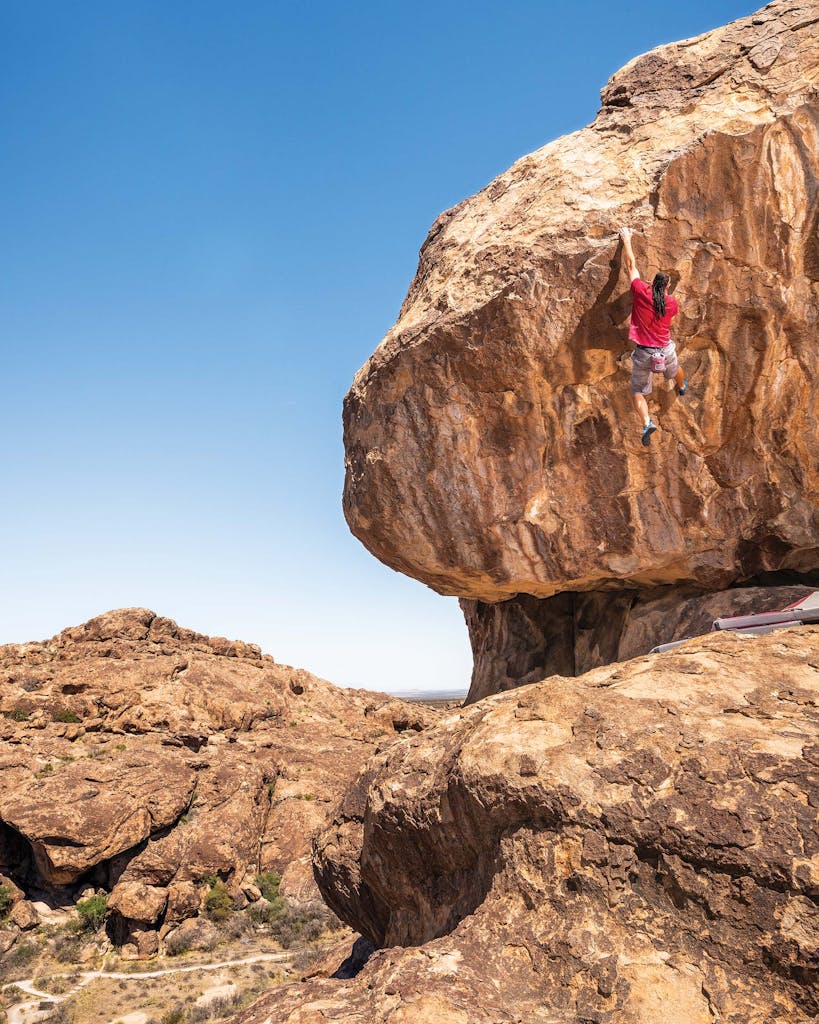
Kehl is perhaps best known in the climbing world for the first ascent, in 2002, of Evilution, a 55-foot V12 on an enormous boulder in California’s Eastern Sierra region. The thing is terrifying to just look at. Only a handful of people have even attempted a repeat. At Hueco, he has continued to find outrageous climbs. In 2017 he began working on a project called Nymphomaniac. Situated near the top of West Mountain, the problem begins on the roof of an altarlike prominence and then goes over the lip of the roof and onto a pinnacle that looks like Papa Smurf’s hat. The crux requires dangling from your fingers above a hundred-foot precipice. To protect himself from a deadly fall during his many hours working alone, Kehl would tie into a rope fixed to the inside of the altar. It would prevent him from ending up at the bottom of the abyss, but that was about it. “It was either die or, you know, get strung up on the side of the cliff,” he says, shrugging. After more than eighty hours working Nymphomaniac, Kehl finally unlocked the sequence of complex underclings and feet-first toe-hooking.
I’m fascinated by Kehl’s puritanical, ascetic devotion to pushing the boundaries of bouldering, but many new converts are attracted to the sport because it’s accessible, communal, enjoyable, and safe enough. And yet I’ve never bouldered outdoors. What am I missing? When my turn to climb comes up later that day, Kehl suggests a V2 called the Guillotine. Despite the name, this thing is relatively gentle—the overhang’s big holds are spaced out just enough to keep it interesting. My goal is to “flash” the problem—that’s climberspeak for completing the route on the first go. I’ve just watched Martina Mali, Kehl’s wife, cruise up the Guillotine, so I have some beta to rely on. As soon as I pull onto the rock, I feel a welcome sensation—the tug of gravity overcome by my upward-bound mind-body motor. I’ve never touched this rock, yet it somehow feels familiar. I’m trying hard but not so hard that I can’t relax and enjoy the ride. Before I know it, as Mali and Kehl cheer me on, I’m slapping the crux and then climbing to the top of the little cliff. One problem solved, a couple thousand to go at America’s bouldering mecca.


Beyond the air-conditioned indoor gyms, climbers can choose another very Texan way to beat the heat: “deep-water soloing,” in which you solo (climb without a rope or other gear) over, let’s hope, deep water. By far the most popular DWS destination in the state is the cliff-lined Lake Travis, on the Colorado River just west of Austin. Pace Bend Park on Lake Travis holds about eight hundred climbs across twelve coves, accessible by foot. But the catch is that each area is safe only at certain lake levels. You don’t want to shallow-water solo, after all. At Pace Bend, when the lake has plenty of water and the weather’s warm, it’s a party. Climbers hang out in the water on pool noodles or tubes, waiting their turn to scale the cliffs. Falling is half the fun—instead of smacking into a crash pad or swinging into the wall on a rope, you splash down into the water, earning style points for in-air acrobatics.
Because of the ongoing drought, Lake Travis is at near-record lows, making DWS too dangerous. I reached out to Marble Falls resident Adam Mitchell, owner of Rock-About Climbing Adventures, who’s probably the only guide in the country to offer DWS trips. He has a backup plan: Lake Marble Falls, a
constant-level lake farther up the Colorado. On a sunny, warm day this fall, three other climbers and I load onto Mitchell’s boat, a skiff flying a “Come and Take It” flag, and motor a short distance to a band of fifty-foot gray-and-orange limestone topped by prickly pear cactus and Spanish dagger. The water is as deep as fifty feet in places. Mitchell describes the climbing here as choose-your-own-adventure. The routes aren’t named, and grades are beside the point. “This is scarier than people think,” he warns us. Soon enough I find out why.
I watch as Mario Stanley, a Plano-based professional climber and coach who competed on the HBO Max show The Climb last year, confidently makes his way up a fifty-foot line with a small but intimidating roof to navigate near the top. As he approaches the roof he starts tossing loose rock down. Unlike Lake Travis, Marble Falls doesn’t see a lot of climbers, and there is a fair bit of untrundled stone. With shouted help from Mitchell, Stanley maneuvers under and around the roof, dodging cactus, and pulls to the top of the cliff. The only safe way down is to jump. Stanley doesn’t hesitate. He plunges feet-first, his Cody Johnson–designed cowboy hat flying off as he nears the water.
Then it’s my turn. I am usually a calm climber, but I find myself feeling more anxious than bold as I slowly ascend. Why does the glassy surface of the water look hard? As I nearly peel off the wall at one point, a sentence frequently uttered by my two-year-old daughter pops into my head: “I scared.” For some reason, the toddlerspeak calms me down, and I soon find myself at the top of the cliff. But I really, really don’t want to jump. “Remember earlier when I said I wasn’t going to do this?” I yell down to my friends on the boat. It takes me several minutes to finally get up the courage. Pro tip: When jumping into water from a long way up, don’t hold your arms straight out to the sides with your palms facing the water. I learn that lesson the hard way—the impact of the water leaves bruises on my forearms. Still, I’m proud that I didn’t chicken out.
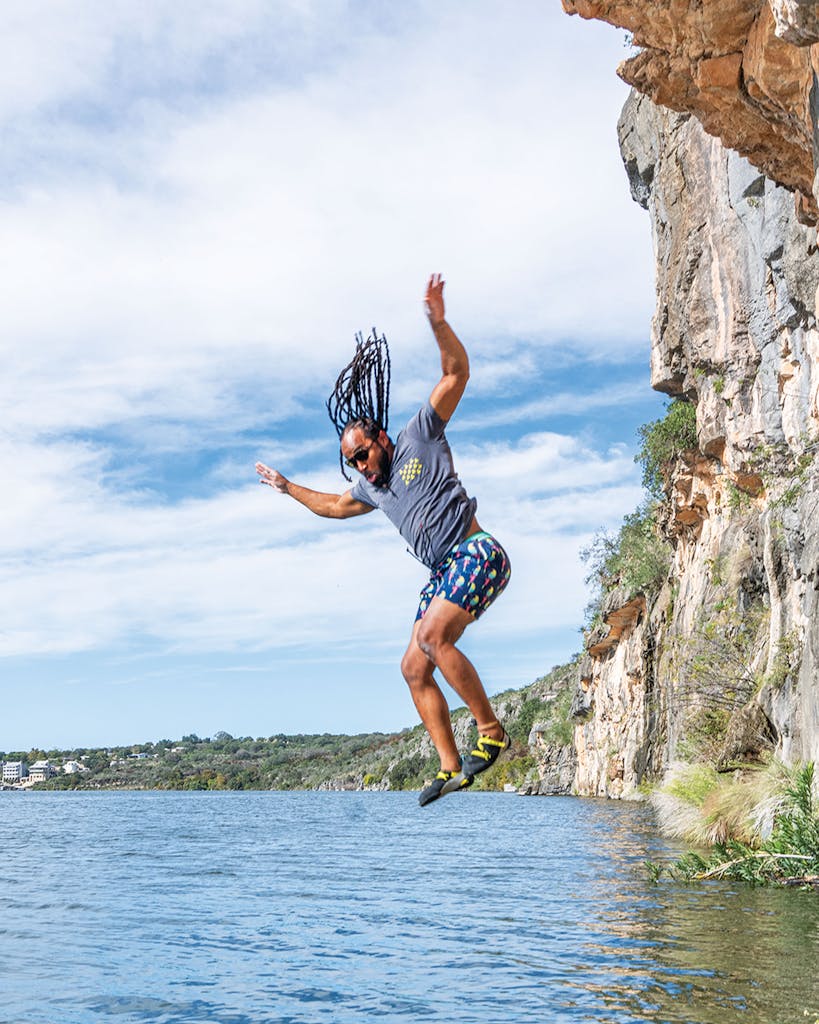
Stanley dreams of buying property in southwest Texas to open a climbing ranch, primarily to help people of color advance in rock climbing. He has been exploring the potential for new routes near the junction of the Pecos and the Rio Grande. He wants to introduce the area, and the sport, to a bigger and more diverse audience. “People in Colorado think I’m insane, but I think Texas has some of the best limestone sport climbing in America.” But most of it’s on private property, inaccessible to the public.
Access is one of the most challenging issues in Texas. Some 95 percent of land is privately owned, and relations between climbers and landowners have been frosty at times. Landowners also have safety and liability concerns. Few if any climbers will spend $5,000 or more on an annual lease, as many hunters are accustomed to doing, says Brian Tickle, the national acquisitions director and the Texas regional director for Access Fund, a climbing advocacy organization. But there are proven models for opening up new areas.
In the eighties, a group of climbers, lured by the highly featured cliffs that hug the Pedernales River, began surreptitiously developing routes on a rugged working ranch, thirty miles west of Austin, owned by the Reimers family, who allowed visitors to swim, fish, or camp for $2 to $3 a car. The outlaw climbers sneaked their drills in with them, in backpacks. Eventually the family caught on, but instead of banning the bolters, the Reimers warmed up to these weirdos and their strange hobby. For a small fee, climbers could spend all day at the ranch. In 2005 the family sold the ranch to Travis County, in part out of devotion to the climbing community. Today, Milton Reimers Ranch Park has developed a reputation for some of the best sport climbing in the state.
In the past five years, several large ranches with stellar rock have opened their gates to climbers. These properties are being passed down to a younger generation looking for new revenue sources and open to recreational activities beyond hunting and fishing. For example, in 2018 Tickle approached the heirs of Inks Ranch, a large spread that features the same pink granite as Enchanted Rock State Natural Area, three miles south. “That kind of granite is about as rare as rocking horse shit in Texas,” he says. He educated the owners about climbing, assuaging concerns regarding safety and worries that fixed anchors would pollute the visual environment. In 2021 Inks Ranch opened to climbing for several weekends per year.
Climbing groups can also buy land. Tickle points to the example of Medicine Wall, one of the few crags in San Antonio. For years, climbers had been scaling privately owned limestone walls along Salado Creek. In 2015, after two men died in a tragic rappelling accident, the landowner began enforcing no-trespassing laws. But then in 2018 the owner—a residential developer—agreed to transfer the property to the nonprofit Texas Climbers Coalition. In 2020 Med Wall reopened, with more than fifty routes accessible from the Salado Creek Greenway trail.
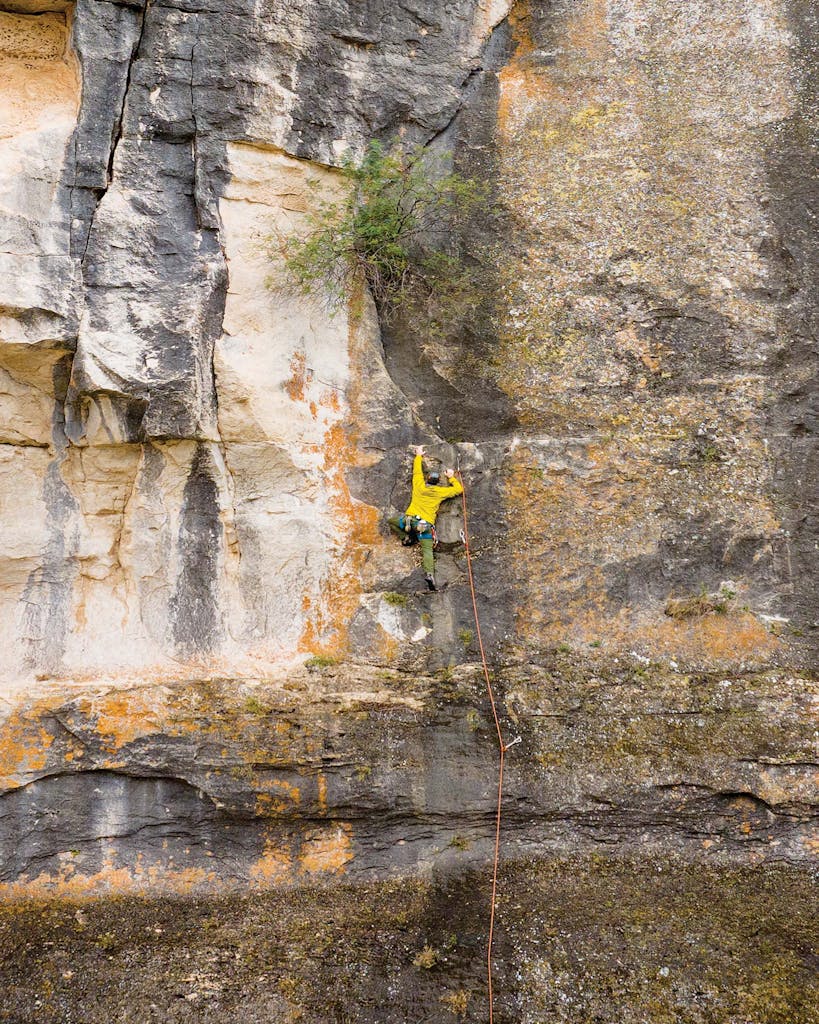
Back at my ranchito, I hug the limestone on that ledge one hundred feet above the Pecos. My friends below are watching, but nothing man-made intrudes. No screen seeks my attention; no highway noise jars the senses. I’m alone with my thoughts. And that’s the problem. I start thinking. I imagine how stupid it would be to mess up the last ten feet—and once that seed of doubt is planted, I keep watering it. What was I doing up here anyway? Why had I become obsessed with something so pointless? What value was there in being a conquistador of the useless, as Patagonia founder Yvon Chouinard once called climbers?
Here I am, a graying, middle-aged desk jockey, clinging to the side of a cliff in the middle of nowhere, when I could be spending time with my family or learning a foreign language. This route is safe enough—and climbing in general is much safer than most people realize—but hadn’t I experienced some close calls, the kind of near misses you don’t tell your loved ones about? Needless to say, the fickle flow state I enjoyed earlier has vanished. Still, there’s no point in quitting now. Once more unto the breach.
I climb poorly, far left of the best way up, forgetting my beta. Nonetheless, I muddle through. A few moves later, I can touch the anchor, the top of the route. All I have to do now, according to the ethics of the sport, is clip my rope into a carabiner at the terminus of the anchor. Then I can, at long last, claim the first ascent. I will have conquered the useless!
But, as you might have guessed, that’s not what happens. When I arrive at the anchor, I fumble around, trying to get into a position to clip it. I can’t find a comfy spot for my feet. Suddenly I’m falling—all the way back to my fateful ledge. I spend several minutes in quiet contemplation before I try the finish again. Done the right way, it’s easy—laughably easy. But it doesn’t count. I must climb from bottom to top without falling.
When I’m back on the ground, my friends are as shocked as I am. It’s as if I had slipped on a banana peel five feet from the finish line of a marathon. I perform some ritual self-flagellation, and mostly I mean it, especially with the drone overhead—but a small part of me is secretly pleased that the mission isn’t done. Because ultimately, as I’ve learned while climbing around Texas, it’s the journey, not the goal, that matters. Like life itself, the Project is unfinished business. Until it isn’t.
This article originally appeared in the February 2024 issue of Texas Monthly with the headline “Rock On, Texas.” Subscribe today.


